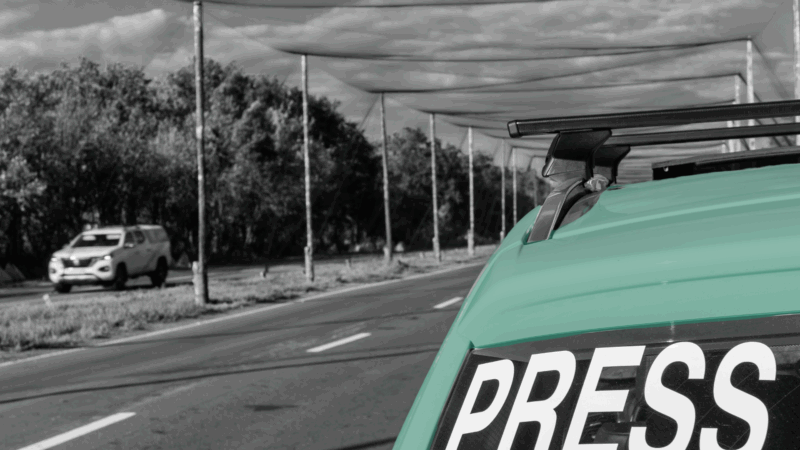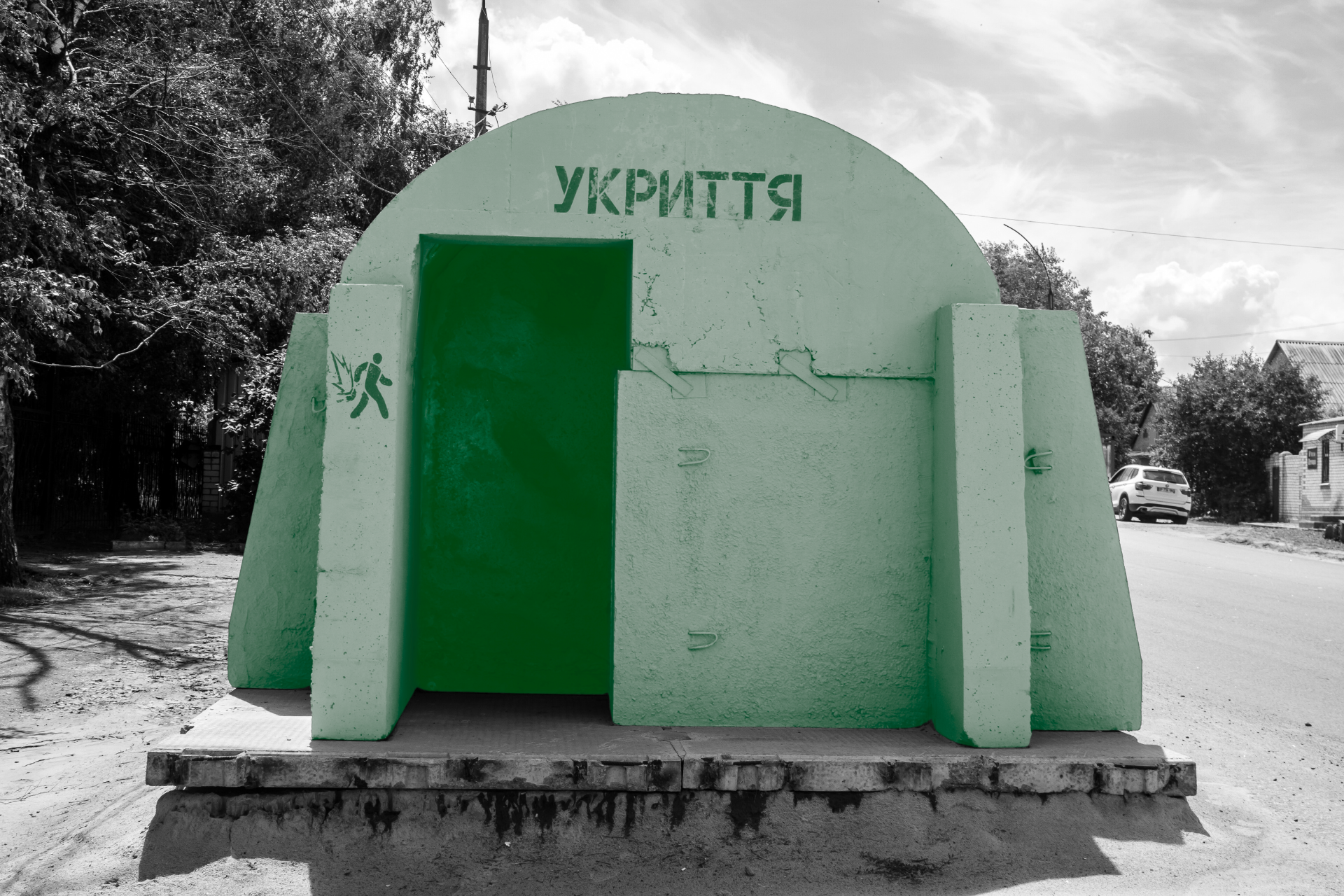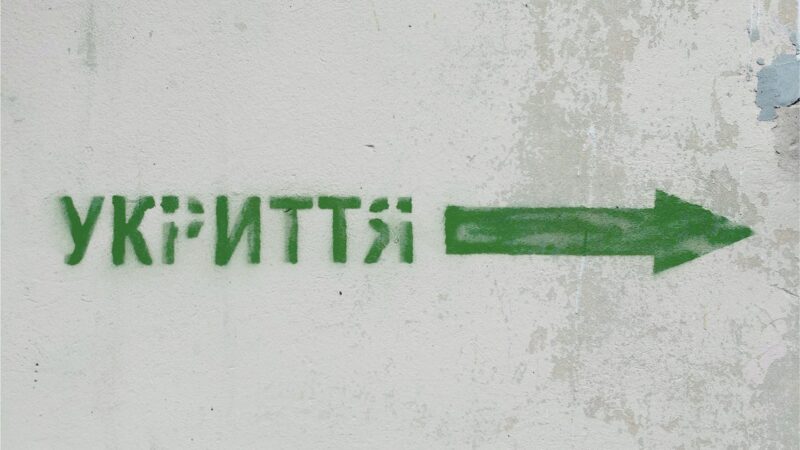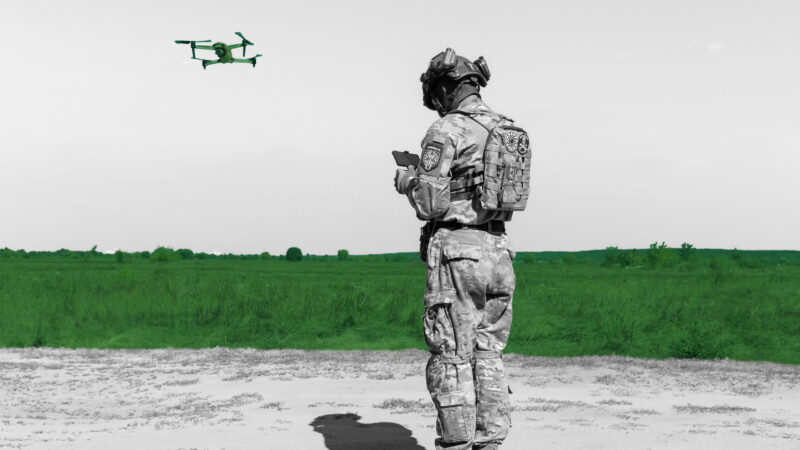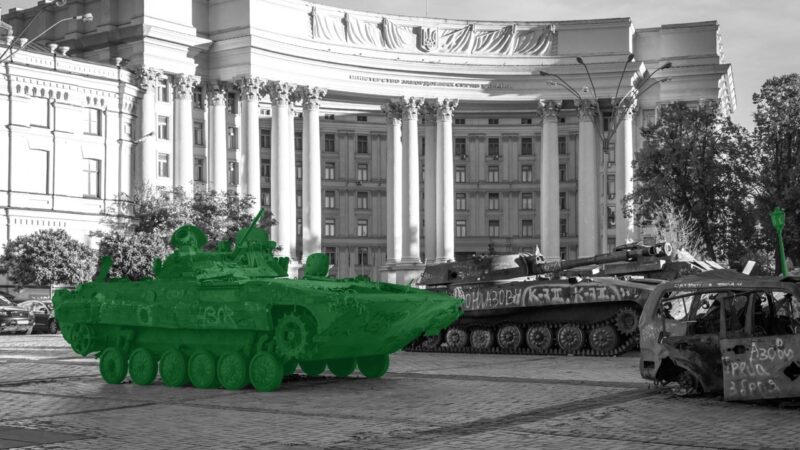Interview with Ihor Poshyvailo | Russian army targets cultural sites in Ukraine: Churches and religious sites play a special role in Ukraine’s resistance
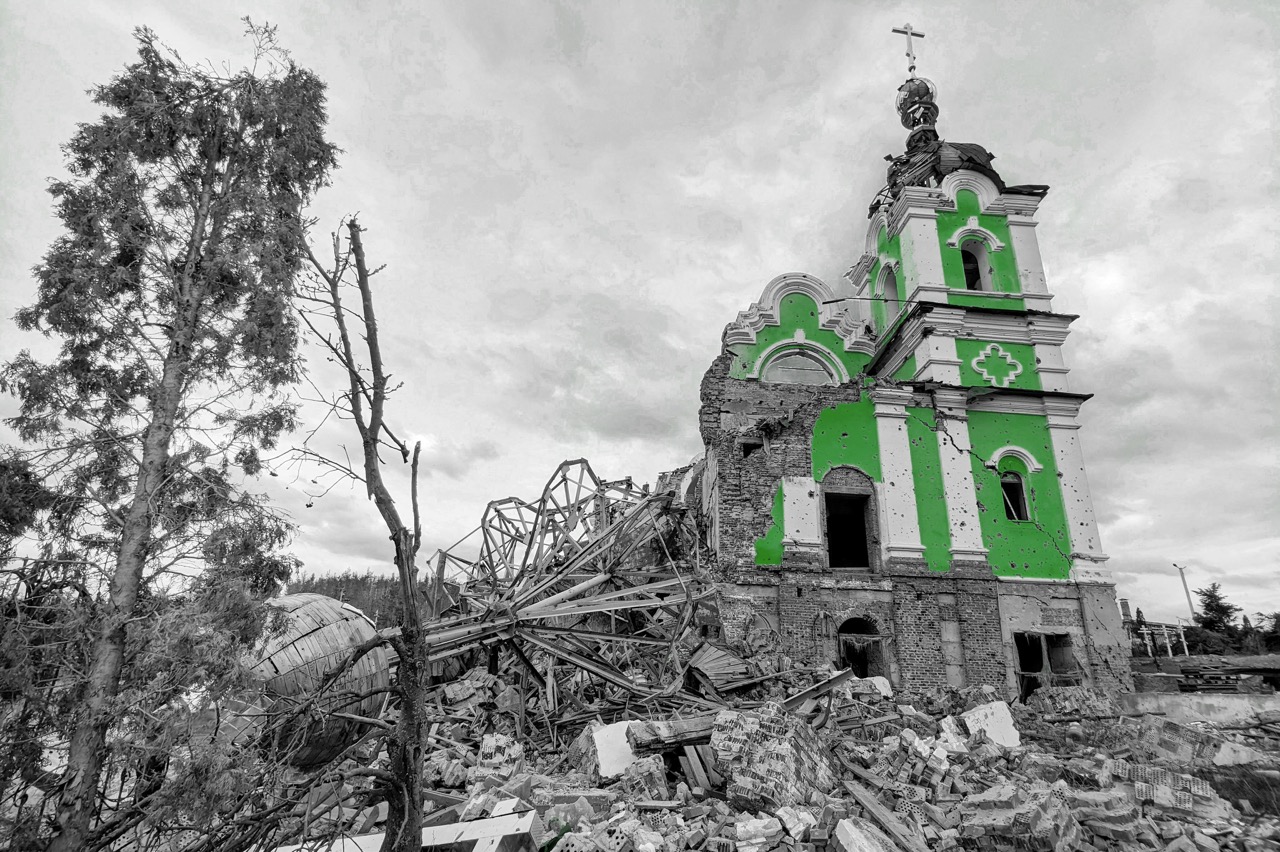
Sean Patterson: You are the director of the National Museum of the Revolution of Dignity, or Maidan Museum, which has been doing groundbreaking work on contemporary history and new commemorative practices in Ukraine. How do you see the Maidan Museum’s role in the present war?
Ihor Poshyvailo: The Maidan Museum was established by the Euromaidan Revolution. The idea of the Maidan Museum was developed at the very heart of the original protest. A small group of activists, including from the grassroots Maidan Self-Defence organization, as well as some representatives of NGOs and Kyiv museums, envisioned an institution that documented the history of this important uprising. It was unclear how events would transpire at that time because it was January 2014, in the middle of the ninety-four-day protest. Still, it was clear to us that we wanted to speak about a future museum—the Maidan Museum, which we were calling the Museum of Freedom (Muzei svobody) at that time. We wanted to address not only the details of the historical event or focus only on the past but also to focus mostly on the future, speaking about human rights and the universal values that brought Ukrainians to the protests. Therefore, the Maidan Museum is formally a historical museum, but in reality it is a kind of museum of memory, human rights, and values.
In connection to the present war, it’s quite clear to us, and all Ukrainians, that the Russo-Ukrainian War is a continuation of Ukraine’s fight for freedom, not only in our contemporary history but across a centuries-long period. One hundred years ago we had the Ukrainian Revolution of 1917–21, and then we had the so-called vyzvol’ni zmahannia [liberation struggle] in the middle of the Second World War. In Soviet times, we had the dissident movement before Ukraine re-established its independence in 1991. We had the students’ Granite Revolution and then the Orange Revolution and the Euromaidan Revolution of Dignity. So, it is one process of Ukrainians fighting for their historical memory and cultural identity, for their future and, of course, for human rights and individual freedoms.
In this connection, the Maidan Museum’s role is clearly defined, because our main declared mission was to document the different manifestations and expressions of freedom, human rights, and the struggle for and defence of Ukraine’s independence. For us, this war is a continuation of the Maidan—and not in a symbolic way, because the war started on February 20, the same day when the largest number of unarmed protesters (later named the Heavenly Hundred heroes) was brutally killed by riot police in Kyiv. Recently, at a press conference, Ukraine’s Office of the General Prosecutor revealed the conclusions of its investigation, confirming the Russian Federation’s presence during the events of the Euromaidan and how Russian secret services influenced the Ukrainian government and president’s actions and responses to the protests. We see Russia’s aggression against Ukraine as a single coordinated process, and we also understand that the Maidan protests destroyed Moscow’s plans to seize Ukraine, stealthily and covertly, through political collaborators at the highest level of government, using hybrid technologies.
When the war started in February 2014, the ongoing Maidan was transformed into a powerful volunteer movement supporting the Ukrainian Armed Forces. Many Maidan protesters, cultural activists, lawyers, scholars, journalists, artists, and medical personnel went to Eastern Ukraine as soldiers and volunteers. In this way, many protesters exchanged their wooden shields and makeshift ammunition for bulletproof body armor and firearms and set out to defend their country. It was quite natural for us to document this process, and in particular the role of the Maidan Revolution’s participants and civil society’s resistance to the occupiers.
When the large-scale war broke out on February 24, 2022, the Maidan Museum initiated and co-founded the Heritage Emergency Response Initiative. Within this initiative we not only launched cultural emergency rescue operations but also expanded our museum work. For example, we collected oral histories on the ground, not only about the events at Maidan but also accounts of cultural and civil resistance to the military aggression. Today, we continue to collect artefacts from the war and document the war’s impact on heritage and crimes against culture.
Patterson: You touched on the importance of memory. Cultural memory operates within a spectrum, tying the local to the regional, national, and even transnational. Could you comment on the interaction between these levels of memory in the current context of the war and how they are changing in response to the war?
Poshyvailo: In Ukraine there was a big problem with cultural memory, which was connected to our historical memory, because during the times of Russian Imperial and Soviet domination, and even in the post-Soviet period, many Ukrainians had yet to rediscover their national identity and cultural historical memory. However, in 1991 quite powerful processes were set into motion. A lot of Ukrainians, especially in the eastern and southern regions, recovered their history and cultural identity. It was quite clear that this was a revelation for many Ukrainians and, especially after Maidan, it was a fantastic moment, a kind of catharsis for many people. Maidan also launched the process of decommunization, and Russia’s large-scale aggression resulted in the first stage of Ukraine’s decolonization policy.
Interactions between different levels of memory—regional, national, and transnational— are quite active at the moment. For example, special institutions that had been created in Ukraine’s capital, such as the Ukrainian Institute of National Remembrance, were transformed after Maidan from a research institution into a governmental institution. The Institute started to establish an infrastructure of memory quite effectively and actively.
Of course, there were various challenges at the regional level due to a lack of educational capacities. There was a large demand, for example, to change the former Soviet or post-Soviet exhibits in small regional town and village museums, where narratives from the Soviet Union still dominated the interpretation of Lenin’s revolution, the Second World War, and Ukrainian-Russian relations in general. Many falsifications and myths about Soviet history in particular were very prominent. In this connection, efforts were launched from the national level. Simultaneously, after the Maidan Revolution many reforms were launched. One of these reforms was administrative decentralization. This meant that the center in Kyiv was not able to exert undue influence on the regions in this regard. It took a lot of time, but the war helped to accelerate the process by which local communities became interested in rediscovering their previously imprisoned memory and the hidden history of their towns and cities, artistic traditions, cultural expressions, rites and customs, and local figures and heroes.
About the transnational level, Ukraine had a great need for methodologies of interpretation and presentation related to traumatic or controversial histories. For example, the Maidan Museum became one of the first Ukrainian members of the International Coalition of Sites of Conscience, which is headquartered in New York. Many museums and institutions in Ukraine that are connected to conflicted or traumatic histories also became members of the Platform of European Memory and Conscience. We needed to learn how to transition our cultural institutions from places that served ideology, as in Soviet times, to places of dialogue whose role is not only to justify the government, especially in traumatic events like wars and social conflicts, but to create a kind of open and dynamic platform for dialogue and peacebuilding—for understanding, healing trauma, and consolidating the nation. This interaction is very active and since 2014 has been strongly supported at the national, regional, and local levels.
In the current context, we also see a great process of cultural memory transformation, even in the occupied territories, because this war is a big shock and stress to Ukrainian society. A lot of people keep asking themselves why this war happened. Why did the Russians do this to us? Before the war, even Putin declared that Ukrainians and Russians are brothers, but on the other hand he said that Ukraine and Ukrainian people do not exist at all as an independent nation. There are large contradictions within Kremlin propaganda, and many people who were under the influence of Russian propaganda for a long time have awakened and are quite open to learning and rediscovering their national and cultural identity in this crisis situation.
For example, we recently hosted a book presentation by the outstanding Ukrainian historian Oleksandr Zinchenko, the author of a book whose translated title is How Ukrainians Destroyed the Empire of Evil. He said that when President Yushchenko recognized Stepan Bandera as a Hero of Ukraine in 2010, the majority of Ukrainians did not support this action because Bandera was still seen quite negatively due to the influence of Soviet propaganda. Five years after the war started in 2014, around fifteen percent of people supported Stepan Bandera as an important Ukrainian historical figure. Zinchenko provides statistics from more recent sociological surveys that show support for Stepan Bandera has grown since the large-scale invasion in 2022 to more than eighty percent. It is the same situation with recognition of the Holodomor as a genocide against Ukrainians. These are very good illustrations of how the crisis situation has influenced and changed people’s thinking about history.
Patterson: The University of Alberta is looking forward to hosting the Maidan Museum’s “Destroyed Temples of Ukraine” exhibit, which was displayed in Kyiv in 2023. As a curator, what drew you to this topic? What were the key challenges of gathering materials? And what did you learn from your interactions with local communities and museum-goers about the role of religion, Ukrainian collective identity, and memory?
Poshyvailo: Since the large-scale war started, we have launched a number of field expeditions to document the damage caused and assess the risk to objects of cultural infrastructure and heritage. We were really shocked by the destruction of so many religious buildings and sacred sites—not only Orthodox, Catholic, and Evangelical Baptist churches but also synagogues and mosques.
For local people in small communities and villages, the church historically has been a very important place, a communal and educational space where people went to communicate with each other and develop their values, where they really felt themselves as a part of a community and where they could discuss their problems and address all kinds of challenges. In the European tradition, and particularly in Ukrainian villages, the church is a very important site that makes the local community resilient to challenges and crises. In many situations, Ukrainian places of worship are also sites of historical, cultural, and architectural heritage. Many churches are in national and world registers of cultural heritage. For example, the wooden churches of the Carpathian Region are included [as a group] in the UNESCO World Heritage List.
We were shocked that so many of these religious sites—over six hundred now—have been damaged or destroyed during this two-year phase of the war.
One of the first churches attacked by Russian forces was the Church of the Nativity of the Theotokos in the village of Viazivka, located very close to the Belarusian border in the Zhytomyr region in northern Ukraine. I visited it with my team to assess the damage. The church dates to 1862 and was almost completely destroyed in the first days of the large-scale invasion. It is very impactful when you see a wooden church that survived the First and Second World Wars now completely destroyed, and the local community has no resources to address this damage and stabilize the building. You can see that so many generations were raised in unity and maintained it due to this very important site, not only a religious one. For example, in the dome of this church, which was also destroyed and left scattered as debris, you can see a lot of names of local craftsmen who participated in its repairs and reconstruction over the decades. You see the names of local people, craftsmen, and dates from the 1920s, 1950s, and 1970s. During one of the renovations decades ago, an unexploded shell from WW II was discovered in the attic. It was really very painful to see such sacred spaces so cruelly destroyed.
Ukrainians traditionally have a special empathy toward religion and God’s temples or churches. One way in which Ukrainian Orthodox churches differ from Russian Orthodox churches is because local people are allowed to bring their own embroidered ritual cloths (rushnyky) to drape around the icons. Traditionally many icons were painted by local artists, amateur or professional, in the naїve style. Naturally, these sacred objects are very dear to the people. These important sites are like time capsules of historical and cultural memory, collective spiritual knowledge, and the beliefs and practices passed down from generation to generation. Therefore, in documenting the damage of different cultural and heritage sites, we paid special attention to churches, and in this way our project’s goal of sharing with the rest of the world this unprecedented attack on religious freedom was clearly and quickly identified.
We understand that religion is a very important part of human life, especially in times of crisis. People’s belief in something beyond human will can help them, especially in situations that they cannot control at all. Therefore, churches and religious sites play a special role for people’s resistance, resilience, and solidarity in hardship, and we want to tell the story of the attacks on them.
Speaking about local communities, we documented the oral history of many individuals. It was so moving and emotional to listen to them. Stories of local persons, quite advanced in years, who still recollect such facts as, for example, when their grandparents or great-grandparents donated to the establishment of a local church and its maintenance. In particular, one elderly lady told us the story of how her grandmother in the early twentieth century went to Chernihiv and made many personal efforts to receive permission from the Chernihiv authorities to build a large brick church in the small village of Lukashivka. There were very severe battles in this village, while Chernihiv was besieged in today’s war, and their church was badly damaged by the Russian forces, who had stored arms inside and around it.
You cannot hear these stories without tears, because these are really sacred and special places, not only for present individuals and families but for multiple generations. Many people were educated and raised in these spaces and remained closely tuned in to the life of their churches. It is well known that traditionally in Ukraine, when a baby is born, he or she is connected to a church through special baptismal rites, and then there are special rites for marriage and for death. The whole life cycle is connected to the church rituals from birth to death. A temple acts as a location for life’s rites of passage. Ukrainian churches and religious sites are locally specific in style and decoration and very connected to people’s everyday life.
Therefore, it was very hard to see the Russian soldiers use the churches not only as shields—assuming that Ukrainian armed forces would not attack them if they organized their field hospitals or military headquarters or stored arms there—but also as places for interrogating people, torturing and even killing them. We witnessed such instances in many regions. For example, in the village of Mala Komyshuvakha near the town of Izium (Kharkiv oblast) the Russians occupied a church and transformed it into their military headquarters and a hospital for wounded soldiers. Not only the church but all the land around it was full of military infrastructure and trenches—it was heavily mined and fortified. It is a strange thing to see places of worship transform into battlefields. It is also about the different attitudes toward sacredness by Ukrainians and Russians, which are so vivid from the evidence we gathered during our museum’s field research. This is a story we also want to share: it is not only about the damage being done but also the absolutely different worldviews Ukrainians and Russians have on churches and spiritual life.
Patterson: The attempted erasure of Ukraine’s cultural heritage by an imperialist Russia is a recurring theme in Ukrainian history. Putin has expressed his desire to impose an amnesic regime over Ukraine, in which Ukrainian identities are subsumed by Russian hegemony. Could you reflect on this threat of erasure and amnesia in today’s context, and how we as historians can best fight against them?
Poshyvailo: This is a very important aspect of the current war, because we understand that Putin’s regime is fighting Ukraine not only for territory and resources but also with clear political ambitions. Russia is ignoring international military and humanitarian laws and the Hague Convention of 1954, including two established protocols on the wartime protection of cultural property. The destruction did not happen spontaneously due to so-called military necessity but as a result of Putin’s desire to “reboot” the culture of Ukrainians. This was at the core of the Kremlin’s genocidal policy, and there is a lot of evidence for it. Putin clearly demonstrated his readiness and willingness to repeat the imperial and genocidal policy of Peter I, of whom he is so proud and insists that he is a follower. Putin repeats the Russian tsars’ policies of “gathering the Russian lands,” which is, in fact, simply the invasion of other people. Putin also follows in the footsteps of Catherine II, Lenin, Stalin, and other leaders of Russian imperialism and Soviet dictatorship—which means genocide, repression, starvation, warfare, and attacks on other nations’ sovereign territory, language, individual human rights, collective freedoms, historical memory, and cultural identity.
It is quite clear to us that not only the vandalism and looting of Ukrainian historical, cultural, and artistic property but also the intentional destruction of museums, archives, libraries, theatres, cultural centers, monuments, and religious buildings are a carefully planned military and ideological operation of the Putin regime. We have a lot of evidence for this, particularly supplied by international satellites and the Cultural Heritage Monitoring Lab. For example, it was proven that the Russian Army targeted specific iconic cultural sites in Ukraine like the museum in Ivankiv (Kyiv oblast), which housed the collections of famous Ukrainian naïve artists such as Maria Pryimachenko, Hanna Sobachko-Shostak, and others. There was also the direct missile attack on the Museum of Hryhorii Skovoroda in Skovorodynivka, near Kharkiv. Skovoroda is a very significant person to Ukraine’s culture, philosophy, and world outlook, which absolutely differentiates us from the Russians. Another example is the Museum of Roman Shukhevych, Brigadier General of the Ukrainian Insurgent Army, which was intentionally destroyed by a recent Russian attack in Lviv.
There is other evidence as well that the Russian Army in occupied territories removes books from libraries, especially publications about Ukrainian history and culture. By the way, such lists [issued by the Kremlin] of books to be destroyed were found through public sources on social media and included books published by the Maidan Museum. This is so similar to the Nazi German occupation during the Second World War, when books from Ukrainian libraries were burned.
The systematic attempts of the Putin regime to erase culture and reactivate an amnesic policy in Ukraine are very evident. Their propaganda machine is working very effectively worldwide. They produce and disseminate many fakes and disinformation about the Euromaidan as a coup d’état and denigrate the Ukrainians’ civilizational choice of civic progress toward the European Union as an independent state.
In today’s context, we understand that this conflict is a battle not only for Ukraine’s territory but also for its memory and culture. Putin is constructing Russian identity today from Russia’s imperial history and especially Soviet misinterpretations and falsifications of history. Moscow assigns a special role in this to so-called skrepy [staples], which are regarded as ideological foundations. The most simple and widespread example is glorification of the Russians’ exceptional role in the victory of the Second World War—what since Stalin’s time was called the “Great Patriotic War.” More complicated are Kremlin falsifications concerning Ukrainian cultural and national identity, relations between Ukrainians and Russians, and the role of Ukraine in history. When Ukraine regained its independence in 1991, Moscow attacked it with many falsifications concerning the history of Crimea, and later used the same arguments to occupy Crimea and justify their act of aggression.
Very similar propaganda is at play in justifying the so-called “liberation” of the Donbas and “denazification” of Ukraine. They frame this “special operation” as the “liberation” of territories that always belonged to Russia, which historically is a complete lie. In Ukraine, historians and a large part of Ukrainian society often mock Putin as a historian when he displays his absolute ignorance of objective history. However, the ahistorical Russian propaganda is mainly for the domestic consumption of Russian audiences. In this way, the Kremlin regime also tries to brainwash and impose an amnesic state within Russian society, because only in this condition can support for Putin’s aggressive policy be achieved. Similarly, and in parallel, they target local people in occupied Ukrainian territories with such amnesic propaganda. They try to justify their brutal aggression, including the destruction of all the infrastructure and killing local Ukrainians, who are often Russian-speaking.
Patterson: Could you tell us more about the Heritage Emergency Response Initiative that you co-founded? What are the respective roles of grassroots civil society groups, government, and international organizations in its work?
Poshyvailo: When the war started, Ukraine was not ready to effectively respond to such a large-scale attack and protect its cultural heritage. Ukraine did not have enough safe storages or shelters, for example, to relocate movable museum collections. Likewise, we were not able to protect our immovable heritage because the scale of the attack was so intense all over Ukraine. There were no safe places at all. The central government did not have enough time, expertise, human and financial capacity, or resources because it was forced to respond to military aggression in other sectors. In this context, the role of grassroots civil society groups, local governments, and international organizations in responding to protect cultural heritage has become crucial. In the first days of the large-scale invasion I received dozens if not hundreds of calls, mostly from my colleagues outside of Ukraine, with offers to help. Thus, the Heritage Emergency Response Initiative (HERI) becamea voluntary platform launched to respond to the crisis in the first days of March 2022.
Quickly we created a wide network of museums, archives, libraries, and partnerships, coordinating our activities with national and international governments, institutions, and NGOs. Since then, we have received support from organizations like UNESCO, ICOM (International Council of Museums), ICCROM (International Center for Research, Preservation and Restoration of Cultural Values), ICOMOS (International Council on Monuments and Sites), and donors such as the ALIF Foundation, the Prince Claus Foundation, Cultural Emergency Response (CER), the Smithsonian Cultural Rescue Initiative, the World Monument Fund, Europa Nostra, and others. We have conducted a number of rescue operations, offered organizational assistance, disseminated tons of packaging materials and protection equipment, and consulted with hundreds of museums and cultural institutions from almost all regions of Ukraine. We have also put on a number of exhibitions and offered educational and training programs.
It was especially important in that crucial period for Ukrainian society to clarify for ourselves the importance of our cultural heritage: whether we were ready to protect it and determine the role of local communities—not only the central government—in its protection. For example, in the Ivankiv museum, where Maria Pryimachenko’s art collection was housed, local people came to help fight the fire and evacuate the collections. This happened almost everywhere (when possible). In this way, the role of grassroots initiatives, local communities, and different professional organizations became crucial when the central and local governments had neither financial nor human and time resources.
Many regions, towns, and cities were occupied by Russian forces on the same day of the full-scale invasion, especially in Eastern Ukraine. If we speak about the museums there, it was only possible to protect or hide selected precious objects. I know of many cases where local people hid church icons or museum staff personally hid important museum collections from the invaders. In many situations this was the only option, because an official evacuation was impossible. Similar tactics were employed during the Second World War. For example, in Odesa the House of Scientists (the former Tolstoy family mansion) was shelled by the Russian forces. They damaged its grand piano, which dates back to the 19th century and was once played by the famous Hungarian composer Franz Liszt. It is said that during the Second World War, this lavishly decorated piano was painted black to hide its value and protect it from looting by the Nazi German occupiers.
Nowadays, local people and grassroots initiatives similarly have emerged to help institutions and individuals in a time of crisis. This is quite effective, as many rescue actions operate independently and do not need the coordination and approval of central or local governments. The evacuation of movable heritage was the biggest challenge, because in many cases it required following bureaucratic procedures that were simply impossible in wartime. The leaders of cultural institutions or local people had to take on the responsibility and take risks for themselves. We have many examples of really heroic actions taken by people who risked their lives to rescue cultural property.
Patterson: You are also a member of the National Council for the Recovery of Ukraine from the War. Could you tell us a little bit more about the council’s activities, and what role do you see for religious groups and institutions in peacemaking and rebuilding after the war?
Poshyvailo: The National Council for the Recovery of Ukraine was established in April 2022 to respond to the damage caused by the war. It was formed as an advisory body to the Office of the President. The Council is chaired by the Prime Minister of Ukraine and the Head of the Office of the President, and all council members are from Ukrainian government ministries.
The scale and focus of this National Council is multi-level: there are twenty-three thematic working groups engaged in developing different strategies for stabilization, preparation for early recovery, and reconstruction processes. I worked in two groups: historical memory and cultural heritage. There is also a group connected to religion, the reconstruction of religious sites, and how to make religious communities more resilient. These working groups developed strategies and submitted proposals to the Office of the President. The general plan for Ukraine’s recovery and reconstruction was then presented in Lugano, Switzerland, and underwent several revisions.
We believe it is very important at the moment to extensively discuss the topic of recovery and reconstruction. We cannot wait until the war ends, as many heritage, educational, and religious sites are severely damaged. There are several approaches we can take. We can ignore the damage, and there are justifiable reasons to ignore the damage, because there are not enough resources and no guarantee that a church or temple will not be attacked by the Russians again. But on the other hand, we understand that local communities really need these places to be stabilized and recovered for safe usage. We visited a lot of churches after they were damaged, and we saw that many communities have invested a lot of their efforts and resources into the recovery of their buildings, adjusting them to their everyday needs, and returning to religious services and normal life to the extent they can in such conditions. That is one side.
On the other side, we have seen some communities that seem to be not very effective or lack motivation. In these cases, they are not very interested in restoring old churches as monuments of history or architecture, and they are looking for new and more practical buildings. Sometimes the communities are divided in their approach. In Borodianka, where the downtown was completely destroyed, there are differing voices: some people would like to completely reconstruct everything and not leave any sign of traumatic memory in the public space; others say that we should memorialize some elements of the landscape and our civic infrastructure to preserve evidence of the war and educate future generations, not only through books but through preserved objects.
Some communities face challenges, and the local government’s role is crucial in these situations. I believe that the National Council for the Recovery of Ukraine can play a crucial role in developing plans for post-war recovery and implementing methodologies and strategies to stabilize our architectural heritage. For example, we can identify priorities for damaged buildings and sites, create immediate action plans, assess risks, mitigate damage, and engage investment.
In some places, we have witnessed how local communities have tried to bring back icons that they had preserved in their homes to the churches and attempted to recreate an environment closer to normal life. These grassroots efforts make local communities much more united and resilient. Even the transition of Ukrainian parishes away from the Russian Orthodox Church is becoming much more active. A lot of communities really understand now the role of Russia in our history and in today’s situation, and a lot of religious communities understand that Ukraine needs one church, a united Orthodox church which truly serves Ukrainians. This transition is being made consciously, with no force or conflicts. We believe that these religious sites can be platforms for transformation and peacebuilding. This cooperative work and reconstruction is bringing people closer together. These displays of solidarity can be very beneficial for the future in overcoming trauma and consolidating the Ukrainian nation, inspiring it for further reconstruction and prosperity.

